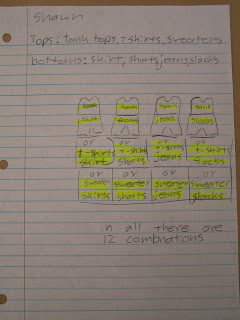A generous student brought these this morning:
Sometimes, as in this situation, we need to multiply more than two numbers:
Each box has 2 rows of 5 cans. There are 2 boxes of soup cans. How many cans of soup is this?
We could think about it this way:
5 cans in each row x 2 rows x 2 boxes: 5 x 2 x 2
The Associative (Grouping) Property of Multiplication says that the grouping of factors can be changed, and the product will stay the same.
First, we tried grouping (5 x 2) x 2.
(Remember that parenthesis used in math mean "please pay attention to me"; do this part first.)
5 x 2 is 10, and 10 x 2 is 20 cans.
Then we tried 5 x (2 x 2).
2 x 2 is 4, and 4 x 5 is 20 cans.
So, no matter which factors you multiply first, you will always get the same product.
(By the way, you can still send in cans of soup until February 1. :-) )











